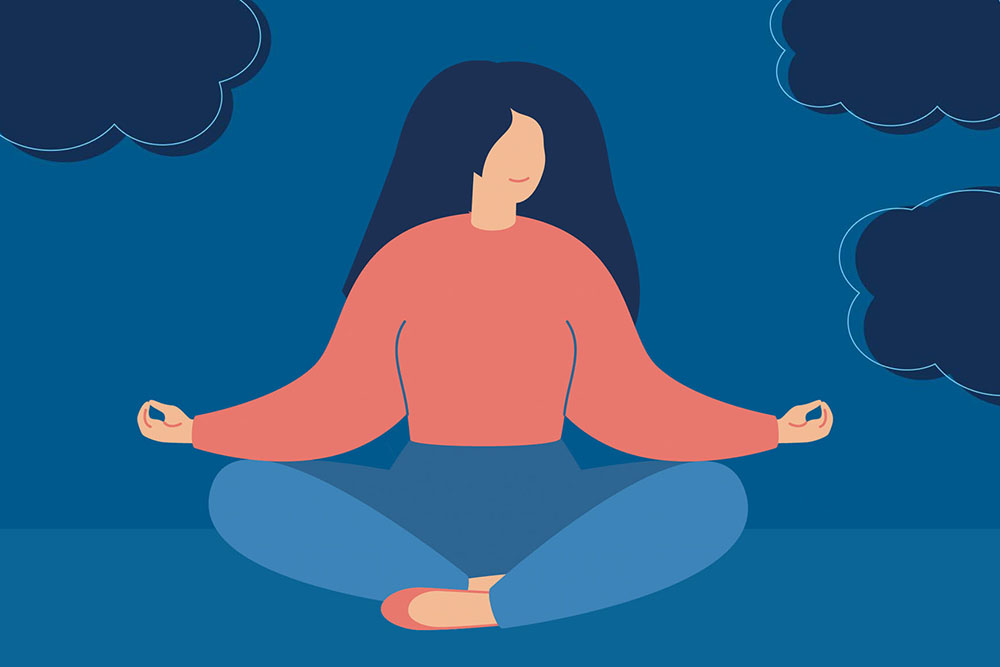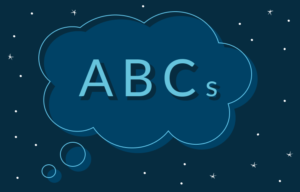For years, I really wanted to meditate. I wanted to be that person who peacefully sat cross-legged with her eyes closed and gathered all these mental and physical benefits I kept hearing about. There used to be a woman at my yoga studio who sat like this with her mala beads for 15 minutes before each class. I would watch her enviously as I twitched and moved around stretching on my mat. But when I would try to sit quietly, I would just become more and more conscious of my pain. Attempting to meditate heightened my awareness of the ever-present throbbing migraine and the burning fire-like nerve pain that had been in my face and head for most of my life. Few things gave me more anxiety than trying to meditate, because it removed all the factors I used to distract myself from my incessant chronic pain.
Finally, one day I tried a full body relaxation meditation and found that it made me feel better both mentally and physically. Next, someone told me to try a “walking meditation.” This was another breakthrough for me when it came to learning to meditate. Over the years, as more preventive medicines came out and as my mentality grew stronger and stronger, I had more moments where my pain level was low enough that I could sit and meditate silently. Now I can say that I am a meditator. I even have some mala beads.
How does meditation help migraine?
But does meditation really DO anything? Does it actually decrease the frequency of our migraine episodes? Does it improve our pain levels or increase our quality of life? Or are we sitting there wasting time?

Meditation changes the brain
There is scientific evidence that meditation actually changes our brains1. Why do we want this?, you might ask. Our brains get very good at doing what they practice. Those of us with chronic migraine have brains that have learned, perfected, and repeated the migraine process. Through the process of neuroplasticity, our brains undergo structural and functional changes, making them more prone to migraine and continual pain as we progress from episodic to chronic migraine. We can see these changes on different types of magnetic resonance imaging (MRI) scans2. For some of us, it may seem that one of our greatest talents is making migraine.
My favorite explanation of the brain changes in chronic migraine and chronic pain came from Amelia Barrett, MD3. She has compared the brain to a symphony. The area of our brain in charge of pain (the pain processing center) is like the percussion section. It has the ability to be loud, noisy, and difficult to ignore. We can think of our emotional center like the string section (cue the violins). Most importantly, there is a conductor – the conductor is the frontal lobe circuitry. The job of the conductor is to keep these other parts in check and working in harmony.
But guess what we see in the MRIs of the brains of those of us with migraine and chronic pain(4,5,6,7)? We’ve lost our conductor. The frontal lobe circuitry is under-active and not really doing its job. Our pain processing center (percussion) is overactive and going berserk. Our emotional center is also over-firing (hint: remember anxiety is three times more prevalent in people with migraine than in the general population8). To make matters worse, the areas related to intellect and higher-level thinking are under-active. This may be one reason why it can be so difficult to think and focus when you have a migraine attack.
So what is the good news? Studies of regular meditation show that we can teach our brains to become practiced at meditation instead of migraine and chronic pain, and thus reverse this process. MRI data of the brains of experienced meditators has shown that their frontal lobe circuitry gets larger, and their percussion and string centers are toned down. Their intellectual centers also come back on line1. In other words, they are strengthening their conductor and calming their pain and emotional centers.
Studies of regular meditation show that we can teach our brains to become practiced at meditation instead of migraine and chronic pain.
Which meditation is best for migraine?
As you might imagine, research studying meditation can get a little tricky since there are multiple forms of meditation, and it is difficult to know how experienced a study subject is. So how can we best apply this to our lives? Many of the first studies were conducted using transcendental meditation, a type of meditation where you focus on a single word or phrase called a mantra, such as “om” or “peaceful.”
Many people find it easiest to start with a meditation app or a guided meditation. Some people prefer something they can feel in their physical body, like progressive muscle relaxation. Progressive muscle relaxation (a systematic relaxation technique) has been shown to reduce migraine frequency9. Other people may like going to a beautiful, peaceful place in their mind with guided visual imagery, or may gravitate towards a prayer-focused meditation.
So, what type of meditation is best? Well, the best meditation is one that you will actually do, and that you personally find beneficial to you.
If you’re like me, you may like to participate in many forms of meditation and relaxation and switch them from day to day. The in-depth MRI study mentioned earlier broke meditation down into four categories:
- focused attention meditation
- mantra recitation meditation (like transcendental meditation)
- open monitoring meditation
- loving-kindness meditations1
The best meditation is one that you will actually do, and that you personally find beneficial to you.

Each category seemed to affect different areas of the brain.
Other types of meditation, mindfulness meditation and mindfulness-based stress reduction, have mixed results when it comes to reducing migraine attacks, but have been shown to reduce disability, improve feelings of depression and anxiety, improve feelings of control and self-efficacy, and improve the quality of life of people with migraine11,12.
One interesting study found that meditation involving a spiritual component did a better job of improving pain tolerance and reducing analgesic medication usage in people with migraine than secular forms of meditation13. Most meditation types help calm the default mode network (the brain center that makes our mind wander) and the emotional center that is overactive in chronic pain and often results in anxiety.
How to use meditation for migraine prevention
Just like preventive medications, meditation and relaxation exercises need to be practiced on a regular basis for a period of time to experience the full benefits. Like many lifestyle changes, it is recommended to practice meditation for about 12 weeks most days of the week to feel the full benefits, and then continue from there to maintain the benefits. Some studies have shown that meditation techniques need to be practiced consistently for at least 20 days before benefits are seen10. Consistency refers to most days of the week (similar to physical exercise). So aim for 4 or more days per week.
What does all this mean? We have yet to find any negative effects of meditation and relaxation exercises. All we have found are positive results on pain and/or the emotional, cognitive, and other factors that affect those of us with migraine. Here are some tips for implementing meditation and relaxation practices into your already full life:
- Find a meditation practice you are drawn to and that you are more likely to stick with.
- Don’t be afraid to “change it up” or try a few different apps or types of meditation.
- Start your meditation practice on one of your better pain days (and/or the best times of the day), not when you’re feeling your worst (this is the mistake I was making).
- Are you finding that meditations that tell you to do a “body scan” or progressive muscle relaxation are difficult for you because they bring too much attention to the pain in your body or head? If so, then skip that type of meditation. Move to one that does not involve a body scan, or skip the head portion of the exercise.
- Make a cozy meditation area in your house that you are drawn to.
- Let the family (especially the kids) know that this is your “meditation time” and you cannot be bothered unless they plan to quietly meditate with you. Silence your phone and other distractions. This is your time.
- If you are a person whose chronic migraine does not afford you a “pain break” and you find it difficult to meditate because of your pain, try meditating for just 60 seconds at a time.
- Aim to practice most days of the week for about 6 weeks, but if that feels overwhelming, just focus on trying (even if it is a short session) at least every other day for a week.
- Since it takes at least twenty days to see an effect, perhaps commit to one type of meditation for twenty days, then try something new.
- Try meditating with others at a local meditation center or yoga studio.
- Journal about your thoughts and feelings after your meditation experience. You might be surprised at what you write! You may think you wasted your time until you have written proof of the better state your mind is in.
If you remember, one of the types of meditation investigated in at least one MRI study was loving-kindness meditation1. To me, this is one of the simplest forms of meditation. It involves focusing benevolent and loving energy toward yourself and others. It can also be a way to turn our thoughts in a more positive direction if pain or other migraine symptoms are starting to bring us down. On that note, I will end by sending benevolent and loving energy to you all and wishing you success on your personal meditation journey.
Juva Health: Biofeedback for Migraine
The Juva Health app teaches you migraine progressive muscle relaxation along with other science-backed migraine relaxation, stress management, and CBT techniques. Using unique technology, Juva makes it possible for you to learn and practice biofeedback for migraine prevention at home. The Juva app uses your phone’s technology to help make you aware of your bodily functions, like heart rate and respiratory rate.
To get access to the best relaxation strategies for migraine, including progressive muscle relaxation, sign up for a free year of Juva Health today.

References
1Fox KC, Dixon ML, Nijevoer S, Girn M, Floman JL, Lifshitz M, Ellamil M, Sedlmeier P, Christoff K. Functional neuroanatomy of meditation: A review and meta-analysis of 78 functional neuroimaging investigations. Neurosci Biobehav Rev. 2016 Jun;65:208-28.
2Lovati C, Giani L, Mele F, Sinelli A, Tien TT, Preziosa G, Mariani C. Brain plasticity and migraine transformation: fMRI evidences. Expert Rev Neurother. 2016 Dec;16(12):1413-1425.
3Weitzel LB, (Host). Meditation, Neuroplasticity, Migraine, and Pain. (No. 95 Guest: Barrett AS). In Heads UP. National Headache Foundation.
4Davis KD, Moayedi M. Central mechanisms of pain revealed through functional and structural MRI. J Neuroimmune Pharmacol. 2013 Jun;8(3):518-34.
5Seminowicz DA and Moayedi M The dorsolateral prefrontal cortex in acute and chronic pain. J Pain. 2017 Sep;18(9):1027-1035.
6Grazzi L, Chiapparini L, Ferraro S, Usai S, Andrasik F, Mandelli ML, Bruzzone MG, Bussone G. Chronic migraine with medication overuse pre-post withdrawal of symptomatic medication: clinical results and fMRI correlations. Headache. 2010 Jun;50(6):998-1004.
7Bashir A, Liptorn RB, Ashina S, Ashina M. Migraine and structural changes in the brain: a systematic review and meta-analysis. Neurology. 2013 Oct 1;81(14):1260-8.
8Buse DC, Reed ML, Fanning KM, Bostic R, Dodick DW, Schwedt TJ, Munjal S, Singh P, Lipton RB. Comorbid and co-occurring conditions in migraine and associated risk of increasing headache pain intensity and headache frequency: results of the migraine in America symptoms and treatment (MAST) study. J Headache Pain. 2020 Mar 2;21(1):23.
9Meyer B, Keller A, Wohlbier HG, Overath CH, Muller B, Kropp P. Progressive muscle relaxation reduces migraine frequency and normalizes amplitudes of contingent negative variation (CNV). J Headache Pain. 2016;17:37.
10Waccholtz A, Vohra R, Metzger A. A reanalysis of a randomized trial on meditation for migraine headaches: Distraction is not enough but meditation takes time. Complement Ther Med. 2019 Oct;46:136-143.
11Wells RE, O’Connell N, Pierce CR, Estave P, Penzien DB, Loder E, Zeidan F, Houle TT. Effectiveness of mindfulness meditation vs. headache education for adults with migraine: A randomized clinical trial. JAMA Intern Med. 2021 Mar 1;181(3):317-328.
12Wells RE, Seng EK, Edwards RR, Victorson DE, Pierce CR, Rosenberg L, Napadow V, Schuman-Olivier Z. Mindfulness in migraine: a narrative review. Expert Rev Neurother. 2020 Mar;20(3):207-225.
13Wachholtz AB, Malone CD, Pargament KI. Effect of different meditation types on migraine headache medication use. Bahav Med. Jan-Mar 2017;43(1):1-8.



